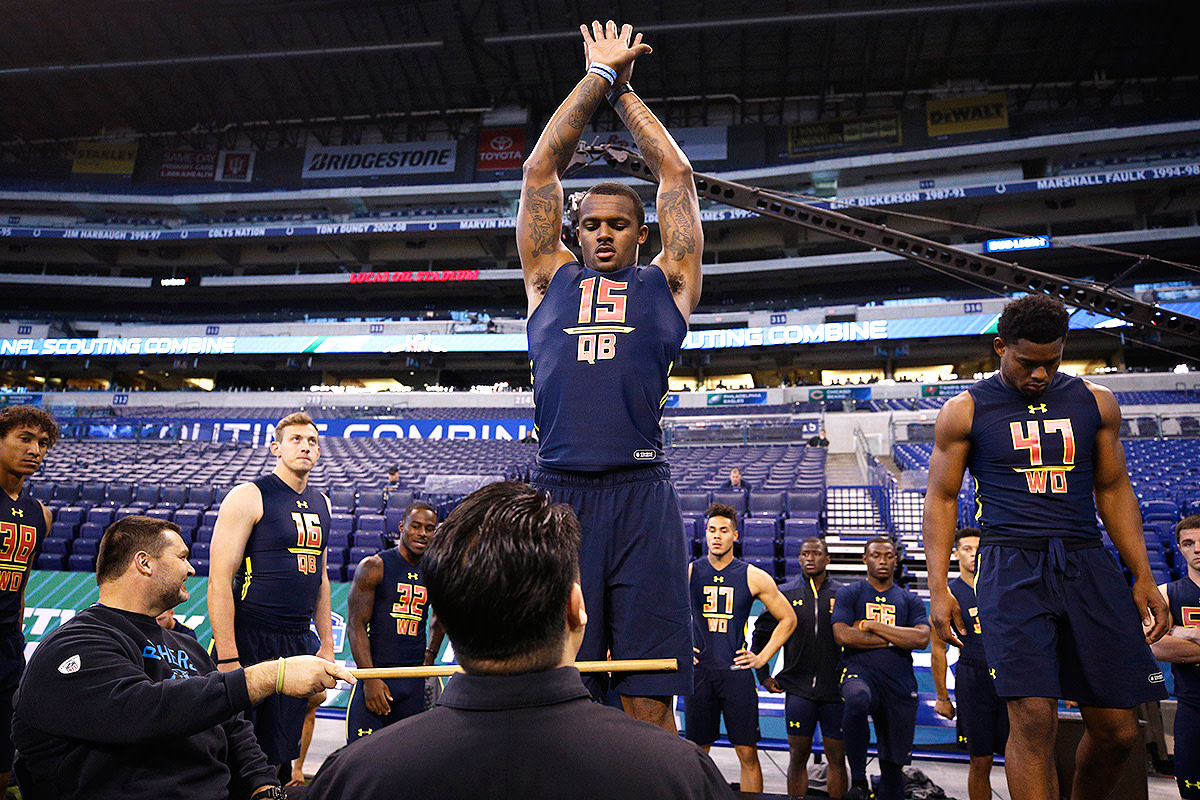How Are Players Selected for the NFL Scouting Combine? Jeff Foster Takes Us Inside the Process

Understand this: The NFL’s National Scouting Combine is a mammoth event. Over 300 NFL prospects fly into Indianapolis about two months before the NFL draft to undergo medical testing, sit down for interviews with all 32 teams and participate in on-field workouts. It’s also a symposium for sports tech companies; a networking event for NFL coaches, scouts and media; and the de facto kickoff to free agency, when the illegal negotiations for free agents, known as tampering when it happens before the official start to free agency, begin in earnest.
But before all that can start, Jeff Foster has to compile a list of invitees, a process he tweaked in 2017 as president of the National Football Scouting Inc. (NFS), which puts on the combine each year. Foster occasionally receives the ire of NFL agents, frustrated that their players did not make the cut, but more often than not, the job he does organizing the combine—and specifically, player selection—is applauded throughout the NFL. Here, he answers some questions about the process.
Robert Klemko: Many people often look at the players who go to the combine and don’t get drafted, and the guys that don’t get invited and do get drafted, as evidence that these teams and your service don’t do a good enough job picking the players. Are you constantly tweaking your approach to selection?
Jeff Foster: No question. During the time that I’ve been here, something that we’ve tried to improve upon is the selection process. We rely on the clubs to tell us who they want to see at the combine. And over the course of the 12 or 13 years I’ve been here, we’ve changed that process looking at some of the same things you’re looking at. How many guys are drafted every year that don’t get invited to the combine? Up until last year that number hovered somewhere around 40. Last year after we changed the process, and that that number dropped to 26. And then we have guys who are drafted who are not allowed to attend the combine. Like anything, trying to please 32 teams or understand what 32 teams want is a challenge.
Klemko: How difficult is it to narrow down those last few guys that make the cut?
Foster: We’ve always felt there were 25-50 players at the bottom of the list who are very similar to the 25-50 players on the outside looking in. We want to select the very best who have the opportunity to not only get drafted but make the 53-man roster, so as you’re evaluating a player, you’re projecting where’s he going to be in two or three years. As the process has evolved, one of the things we’ve done, we used to have a committee meet in mid-December to talk about players that have unique eligibility situations. Now we do that at the end of the process, and we use that committee to determine who the last 50 are.
One other thing we added a few years ago is we send communication to coaches who have players being considered, and it gives them opportunity to tell us if they feel strongly that we missed somebody. Obviously a college coach who’s been with an athlete for four or five years know that player better than anybody, so we take it very seriously if an active college coach contacts us. The process we started last year was to involve all 32 clubs in the evaluation and selection process, and we used the same process this year to see if that was a one-year blip or a function of an improved process.
• BREER: NFL Mock Draft 2.0—The Pre-Combine, Pre-Free Agency Projection
Klemko: When you get down to the last few guys, and you have two similar players, but one has a clean medical sheet, clean off-the-field record, and the other has, say, a torn ACL from high school and a couple of arrests, is precedent given to the guy with issues, because teams need to learn more about him?
Foster: If we have that type of history on a player we will discuss those issues. The No. 1 priority of the combine is medical evaluation. Most of the players, we know between 80% and 90% of who they are as a player before they arrive, and we need to know the medical. I’ve had an agent say to me, that player on your list hurt himself in training, so can this other guy come to the combine now? Those are the silly questions we get from agents. And I’ll explain that actually that with the player who’s injured, it’s probably more important that he come to the combine now. We recognize when a player has a significant injury, but most of the time, we’re trying to determine who we think is going to be the better player.
Klemko: How do you decide how many players from each position get invited?
Foster: We try to let the talent pool dictate how many guys we have at each position. We understand and look at the averages of how many guys are drafted at each position. We know we want to be around a dozen quarterbacks—last year it was very difficult to get to 12, and this year we had a tough time cutting down to 12. Last year there weren’t a lot of linebackers, but this year if you were to ask me if there’s a player who will get drafted who wasn’t invited to the combine, I would say I hope not, but if there is he’ll probably be a linebacker.
Klemko: Why not expand the combine and guarantee that every player drafted will be evaluated in Indianapolis?
Foster: What number do you go to in order to ensure you that you get the 255 who will be drafted? We’re at 336 this year. If we [increased the number of players] to 400 you might still miss one, so then do you go to 410? Where does it stop? There’s always going to be guys who slip through the cracks. From a cost-benefit analysis, you have to figure out where that sweet spot is. We try to be fiscally responsible with our process—we have a budget like most organizations. If we’re stretching another 30-40 players at [a certain amount of money per] player, just to capture the last few guys who may be drafted in the last round, where’s the sense in that? Teams have an opportunity to do medical evaluations on guys on their own with their Top-30 visits. It’s mostly driven by logistics. We have guys who need four, five or six MRIs when they come through.
Klemko: One example people who want the combine to expand will point to is Kevin Byard, was drafted in the third round two years ago, and was a first-team All-Pro last year. How do you avoid missing all the Byards out there?
Foster: We ask ourselves what we could have done differently. It’s no different than teams going back and looking at Tom Brady and how everyone missed. You want to try to learn from it and say, what do we need to do differently to not miss guys like that? But you also want to commend that player for being able to accomplish their goals without the combine. The combine is an important step, but not going doesn’t mean you can’t be successful. The ultimate goal for a player is not to come to the combine, it’s to play in the NFL.
Klemko: Are there guys who might have been drafted if not for flaws that were discovered at the combine?
Foster: That’s tough to evaluate. Of those 35-50 players who are on the bottom end, how many of them come to the combine and for whatever reason—medical, physical, performance, personality—does something that the clubs learn at the combine cause that player to drop below the draft line, raising a player below that line who excels in the rest of the evaluation process? I think there are examples of that.

Klemko: How do you manage the growing number of underclassmen in the selection process?
Foster: We had the highest number of underclassmen declare this year, and we do not evaluate any of them until they’ve declared. Its our hope that all of those players stay in school, because we think it’s important for them as individuals, important for their schools and important for the NFL because what better place for a player to develop than at a major university in his senior year. The caliber of play in the NFL is positively impacted when players stay in school. When those underclassmen declare, the teams start scrambling to evaluate them. You don’t get to see them at all-star games. So the committee ends up bearing on the side of caution with those guys.
Klemko: How did you expand the evaluation to all 32?
Foster: In the past the committee had been comprised of 12-15 NFL teams in addition to the national scouting services. This year we invited all clubs to participate on the front end, and that’s evaluating all the seniors. Right as the college season is ending, we invited all the teams to participate. We built an online portal where they can securely and private send us information about players. It’s really just a voting process. By allowing all the teams to offer input if they want to, it gave us a larger set of data. Then you have the committee, which is comprised of GMs, owners, directors of college scouting, national scouts. We keep them private because we want the process to be private.
Klemko: Is that so agents don’t know who to lobby?
Foster: There’s not lobbying involved in this process. A lot of times I’ll have agents call me and say this player is at this all-star game, why isn’t he at the combine? Well, I cant speak intelligently about the selection process for an all-star game, but having worked for one, I can tell you there are a lot of measuring sticks. They want the best players, but they also need good representation from different schools, especially locals. They need to put butts in the seats, and they have television to consider.
For the combine we’ve tried very hard to make it clear that this is based on performance and merit. And it’s not perfect, it’s subjective. I’ve had college coaches complain to me, why didn’t this guy get in? Well, potentially we’ve made a mistake. It’s a subjective business. That last 50 [selected players] is really hard, and there are a lot of deserving candidates. I’m always disappointed when there is a player who we have high marks on and we don’t end up adding him. And I have conversations with those players about all the great players that didn’t go to the combine who went on to have great careers.
